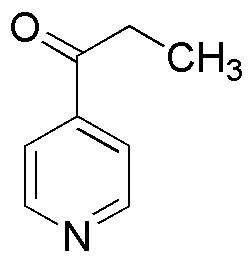3-Pyridyl ethyl ketone is widely utilized in research focused on:
- Pharmaceutical Development: This compound serves as a key intermediate in the synthesis of various pharmaceuticals, particularly those targeting neurological disorders. Its unique structure allows for the modification of drug properties to enhance efficacy.
- Agricultural Chemicals: It is used in formulating agrochemicals, including herbicides and insecticides, due to its effectiveness in disrupting pest metabolism, providing a safer alternative to traditional chemicals.
- Flavor and Fragrance Industry: The compound is incorporated into flavoring agents and fragrances, offering a distinctive aromatic profile that enhances consumer products like perfumes and food additives.
- Material Science: 3-Pyridyl ethyl ketone is employed in the development of polymers and resins, improving their thermal stability and mechanical properties, which is crucial for applications in coatings and adhesives.
- Analytical Chemistry: It acts as a reagent in various analytical methods, aiding in the detection and quantification of other compounds, which is essential for quality control in manufacturing processes.
General Information
Properties
Safety and Regulations
Applications
3-Pyridyl ethyl ketone is widely utilized in research focused on:
- Pharmaceutical Development: This compound serves as a key intermediate in the synthesis of various pharmaceuticals, particularly those targeting neurological disorders. Its unique structure allows for the modification of drug properties to enhance efficacy.
- Agricultural Chemicals: It is used in formulating agrochemicals, including herbicides and insecticides, due to its effectiveness in disrupting pest metabolism, providing a safer alternative to traditional chemicals.
- Flavor and Fragrance Industry: The compound is incorporated into flavoring agents and fragrances, offering a distinctive aromatic profile that enhances consumer products like perfumes and food additives.
- Material Science: 3-Pyridyl ethyl ketone is employed in the development of polymers and resins, improving their thermal stability and mechanical properties, which is crucial for applications in coatings and adhesives.
- Analytical Chemistry: It acts as a reagent in various analytical methods, aiding in the detection and quantification of other compounds, which is essential for quality control in manufacturing processes.
Documents
Safety Data Sheets (SDS)
The SDS provides comprehensive safety information on handling, storage, and disposal of the product.
Product Specification (PS)
The PS provides a comprehensive breakdown of the product’s properties, including chemical composition, physical state, purity, and storage requirements. It also details acceptable quality ranges and the product's intended applications.
Certificates of Analysis (COA)
Search for Certificates of Analysis (COA) by entering the products Lot Number. Lot and Batch Numbers can be found on a product’s label following the words ‘Lot’ or ‘Batch’.
*Catalog Number
*Lot Number
Certificates Of Origin (COO)
This COO confirms the country where the product was manufactured, and also details the materials and components used in it and whether it is derived from natural, synthetic, or other specific sources. This certificate may be required for customs, trade, and regulatory compliance.
*Catalog Number
*Lot Number
Safety Data Sheets (SDS)
The SDS provides comprehensive safety information on handling, storage, and disposal of the product.
DownloadProduct Specification (PS)
The PS provides a comprehensive breakdown of the product’s properties, including chemical composition, physical state, purity, and storage requirements. It also details acceptable quality ranges and the product's intended applications.
DownloadCertificates of Analysis (COA)
Search for Certificates of Analysis (COA) by entering the products Lot Number. Lot and Batch Numbers can be found on a product’s label following the words ‘Lot’ or ‘Batch’.
*Catalog Number
*Lot Number
Certificates Of Origin (COO)
This COO confirms the country where the product was manufactured, and also details the materials and components used in it and whether it is derived from natural, synthetic, or other specific sources. This certificate may be required for customs, trade, and regulatory compliance.


